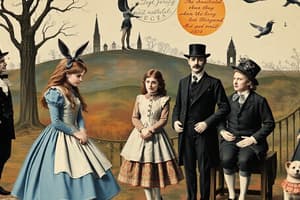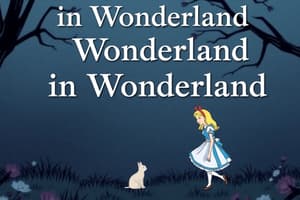Podcast
Questions and Answers
What is the primary significance of the symbolic meanings found in Alice's Adventures in Wonderland?
What is the primary significance of the symbolic meanings found in Alice's Adventures in Wonderland?
- They are irrelevant and only add confusion to the story.
- They are purely decorative and add whimsy to the narrative.
- They offer insights into Victorian society's anxieties and challenges. (correct)
- They provide a literal understanding of the story's plot.
What is the primary purpose of the nonsensical elements in Alice's Adventures in Wonderland?
What is the primary purpose of the nonsensical elements in Alice's Adventures in Wonderland?
- To confuse the reader and make the story harder to follow
- To create a fantastical world that is purely for entertainment purposes
- To illustrate the illogical nature of the world and critique social norms (correct)
- To provide a distraction from the main themes of the narrative
Which character in Alice's Adventures in Wonderland is most representative of societal anxiety and its pressures?
Which character in Alice's Adventures in Wonderland is most representative of societal anxiety and its pressures?
- The White Rabbit (correct)
- The Dormouse
- The Cheshire Cat
- The Mad Hatter
What broader theme is reflected by the erratic and time-obsessed behavior of the Mad Hatter?
What broader theme is reflected by the erratic and time-obsessed behavior of the Mad Hatter?
Which aspect of Alice's experience in Wonderland best reflects the theme of personal identity?
Which aspect of Alice's experience in Wonderland best reflects the theme of personal identity?
The Queen of Hearts' character most clearly represents which societal theme?
The Queen of Hearts' character most clearly represents which societal theme?
What is the literary style that Alice's Adventures in Wonderland uses to expose absurdity and make fun of human flaws?
What is the literary style that Alice's Adventures in Wonderland uses to expose absurdity and make fun of human flaws?
Which of the following best describes the literary device of 'nonsense' as it is used in the novel?
Which of the following best describes the literary device of 'nonsense' as it is used in the novel?
What does Alice's journey through Wonderland primarily symbolize?
What does Alice's journey through Wonderland primarily symbolize?
Flashcards
Symbolism in Alice's Adventures in Wonderland
Symbolism in Alice's Adventures in Wonderland
The use of symbols and characters to represent abstract ideas or themes.
Allegory in Alice's Adventures in Wonderland
Allegory in Alice's Adventures in Wonderland
The way the story indirectly references Victorian society, its values, and issues.
Victorian Social Context in Alice's Adventures in Wonderland
Victorian Social Context in Alice's Adventures in Wonderland
The novel reflects concerns and changes happening in Victorian society, like social anxieties and shifts.
Thematic Exploration in Alice's Adventures in Wonderland
Thematic Exploration in Alice's Adventures in Wonderland
Signup and view all the flashcards
Enduring Significance of Alice's Adventures in Wonderland
Enduring Significance of Alice's Adventures in Wonderland
Signup and view all the flashcards
Who is Alice?
Who is Alice?
Signup and view all the flashcards
What does the White Rabbit represent?
What does the White Rabbit represent?
Signup and view all the flashcards
Who is the Cheshire Cat?
Who is the Cheshire Cat?
Signup and view all the flashcards
What is the Mad Hatter like?
What is the Mad Hatter like?
Signup and view all the flashcards
What does the Queen of Hearts represent?
What does the Queen of Hearts represent?
Signup and view all the flashcards
What is a key theme in Alice's Adventures in Wonderland?
What is a key theme in Alice's Adventures in Wonderland?
Signup and view all the flashcards
What is the literary style of Alice's Adventures in Wonderland?
What is the literary style of Alice's Adventures in Wonderland?
Signup and view all the flashcards
What does Alice's journey represent?
What does Alice's journey represent?
Signup and view all the flashcards
Study Notes
Summary of Alice's Adventures in Wonderland
- Lewis Carroll's novel, Alice's Adventures in Wonderland, published in 1865, is a classic of children's literature.
- The narrative follows Alice, a young girl who falls down a rabbit hole, entering a bizarre and illogical world.
- The characters and events in this world are often nonsensical, using humor and absurdity to depict the anxieties and absurdities of society.
- The book utilizes clever wordplay, puns, and satire.
Main Characters
- Alice: The protagonist, a curious and observant young girl. She struggles to navigate the changing landscapes and situations.
- The White Rabbit: A hurried and important-seeming character who sets the plot in motion. He represents outward appearances and societal pressures.
- The Cheshire Cat: A mysterious and enigmatic character who offers cryptic advice and insights into Wonderland's rules.
- The Mad Hatter: A character obsessed with time, and whose erratic behaviour reflects broader themes of societal disorder.
- The March Hare: Another eccentric character in Wonderland, reflecting a detachment from reality. Notable for his lack of a steady, rational approach to life.
- The Queen of Hearts: Represents lawlessness, arbitrariness, and the unpredictable nature of power. Her character often emphasizes capricious and unjust rulings.
- The Dormouse: A character representing idleness or apathy.
Key Themes
- Growing up and facing the unknown. Alice's journey mirrors her personal growth and struggles.
- Social commentary. Many characters and situations reflect social and political events of the time.
- The nature of reality and logic. The book challenges readers to question the rules of logic and reason in the face of the illogical.
- Identity and personal perception. Alice struggles to navigate an ever-shifting reality where roles and perceptions change.
Key Events
- Alice falls down a rabbit hole, and ends in a nonsensical world.
- Encounters with various fantastical creatures and characters in Wonderland.
- Alice tries to return home.
- Challenges involving illogical rules and situations.
Literary Style
- Use of satire: Exposes absurdity and makes fun of human flaws and societal pressures.
- Nonsense: The illogical nature challenges traditional understanding of the world.
- Humor: Uses wit and wordplay to entertain and engage readers.
- Symbolism: Many elements and characters carry symbolic meanings related to different themes, such as societal anxieties and the challenges of growing up.
- Allegory: While not strictly allegorical, the story subtly references various aspects of Victorian life, thoughts and culture indirectly.
Historical Context
- The book reflects the anxieties and changes occurring in Victorian society.
- The narrative also represents the changing social structure in the era.
Significance
- Alice's Adventures in Wonderland resonates with readers of all ages due to its imaginative elements and lasting influence on popular culture.
- The novel explores themes of identity, relationships, and the changing world.
- The book remains relevant due to its timeless explorations of social and psychological issues.
Studying That Suits You
Use AI to generate personalized quizzes and flashcards to suit your learning preferences.




